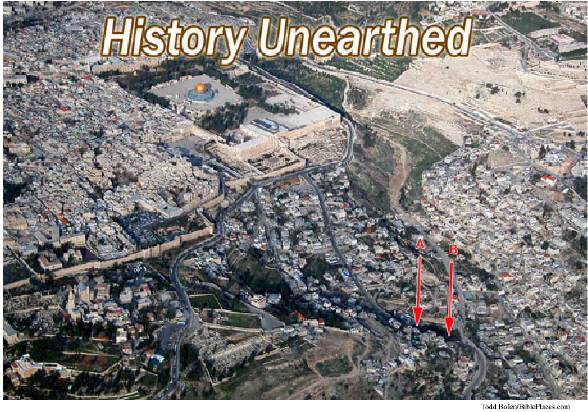History Unearthed -- By: Marion Fischel
Journal: Bible and Spade (Second Run)
Volume: BSPADE 17:4 (Fall 2004)
Article: History Unearthed
Author: Marion Fischel
BSpade 17:4 (Fall 2004) p. 113
History Unearthed

Ariel view of Jerusalem, with the Temple Mount and City of David. The new excavations are on the west side of the City of David. Letter “A” is where the traditional Pool of Siloam is located, but what archaeologists now believe is not earlier than the Byzantine period. Just south of that, at letter “B,” is the Birket el-Hamra (“earthen pool”), which excavations have shown to be the Biblical Pool of Siloam. The Talmud (Sukk. 4.9) states that during the Feast of Tabernacles, which lasted one week, a procession went to the Pool of Siloam to bring water in a golden vessel to the Temple. There it was poured out as a libation of thanksgiving to God. Jesus attended the Feast of Tabernacles in Jerusalem during His ministry (Jn 7). Halfway through the Feast He went to the Temple courts and began to teach (Jn 7:14). Part of His message was, “If anyone is thirsty, let him come to Me and drink. Whoever believes in Me, as the Scripture has said, streams of living water will flow from within him” (Jn 7:37). Jesus may have been comparing the true spiritual life that is available through faith in Him to the “dead” waters of the Pool of Siloam used in the Feast of Tabernacles ceremony (Mare 1992:25).
An Archeological Discovery Sheds Light on the Second Temple-Period Water System
Early in June archeologists explored an area of the City of David that had lain untouched for more than 2, 000 years. What is thought to be the Pool of Siloam, discovered when archeologists decided to check the site before the municipality launched infrastructure work in the area, dates back to the Second Temple period.
“One of the supporting walls of the pool was the southernmost wall of the city,” says Jerusalem regional archeologist John Seligman, who is working on the excavation.
“The wall acted as both a dam and a fortification. The pool was actually a reservoir where the waters of the Gihon Spring were collected for the city. It is a very important find because it helps form our understanding of the water system of Jerusalem in ancient times.”
Seligman works alongside archeologist Eli Shukrun of the Israel Antiquities Authority who, together with Prof. Ronny Reich of Haifa University, has been exploring the area since 1995. Pursuing a gut feeling that there was an interesting discovery to be made, Shukrun and his colleagues set to work brushing away the dirt for several hours, until Shukrun discovered they were working on a step.
�...
Click here to subscribe
